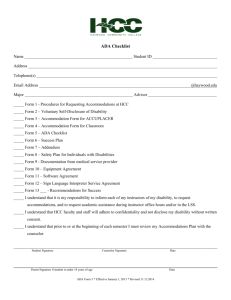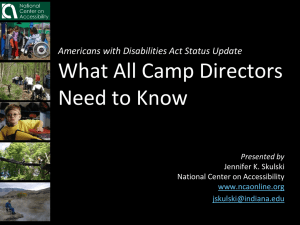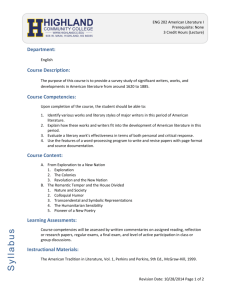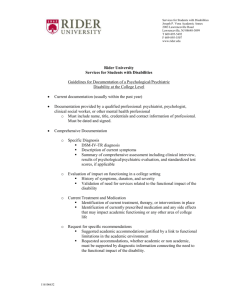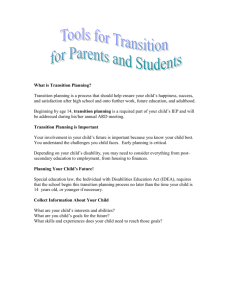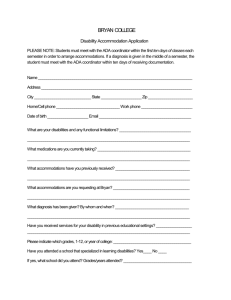Physical Access - Endependence Center Inc
advertisement
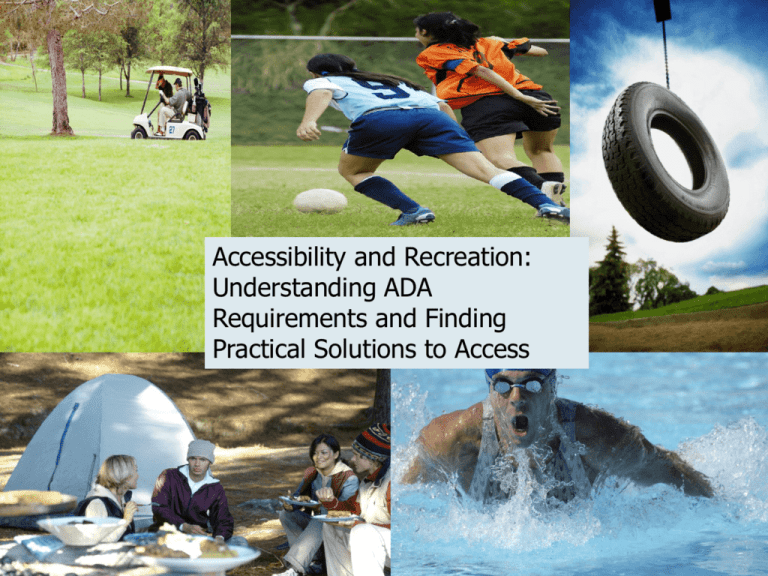
Accessibility and Recreation: Understanding ADA Requirements and Finding Practical Solutions to Access Accessibility and Recreation This training will address: • The basics of the ADA as it applies to recreation services • Simple ways to create program access through: • Policy and Procedural Changes • Auxiliary aids • Physical Accessibility Improvements • Resources for adaptive and assistive technology that can increase access Definition of Disability An individual with a disability is one who: has; has a record of, or; is regarded as having a physical or mental impairment that substantially limits a major life activity. How do you know if a person is covered by the ADA? Yes, you may ask a registrant if they have a covered disability. You may not ask what the disability is. You may wish to have a poster that explains who is covered by the ADA. A disability may not be visible e.g., epilepsy, heart condition, etc. Documentation Can request proof of need for accommodations (changes/assistance/aids) to participate in course Need to be specific to course Can have entrance requirements – Must be functional and focus on skills needed to do training. The Americans with Disabilities Act Title I: Employment Title II: State and Local Government Title III: Public Accommodations Title IV: Telecommunications Title V: Miscellaneous Title II RequirementsState & Local Government Who? – State and Local Government Services and Contractors Four broad areas of requirements: – General Nondiscrimination – Program Accessibility – Equally Effective Communication – Employment – New buildings built accessible Title III RequirementsPublic Accommodations Who? – Any business that provides goods or services to the public – Exemptions: Private clubs, churches General Requirements: – General Nondiscrimination – Equally Effective Communication – Readily Achievable Barrier Removal – New: Built Accessible Non-discrimination No qualified individual with a disability shall solely by the reason of disability be: • excluded from participation, • denied benefits, services, or access to programs or activities, • or be subjected to discrimination by any public entity or private business Modification of Policies, Procedures and Practices Title II and Title III entities must modify policies, procedures and practices in order to allow access for people with disabilities unless causes and undue burden What simple changes could make a difference? Allow an unpaid helper to join person in class at no cost Change entrance requirement in class from “able to stand in 4 feet of water” to “maintain safety in 4 feet of water throughout class” Train staff to offer to help with applications, forms, online forms are accessible Doing art projects with partners in class instead of individually Allowing person extra time in and out of swimming pool before exercise/swimming class Policies - Example A park has a “no animals” policy. An individual who is accompanied by a service animal is denied access to a nature walk because they have a “pet”. Is this ok? Answer: The “no animals” policy must be modified to permit access to a person accompanied by a service animal. Procedures-Example The snack bar has counter service only. An individual of short stature cannot reach the snack bar to get service. What change in procedures may be appropriate? Answer: Answer: Staff may leave the counter area and serve the individual at his or her table. A bell or buzzer may be installed at a lower height to enable an individual to request service. Program Access: Title II Requirement State and local government must provide full “program access” to people with disabilities. - This means that persons with disabilities may not be excluded from a program or service because it is not presently accessible. - May require changes in policies and procedures, location, communication or physical accessibility improvements Integrated Programs Services and programs must be delivered in the most integrated setting appropriate to the person’s level of need even if separate programs exist. – Integration of persons with disabilities is one of the goals or values of the ADA. Children’s Programs Toileting, Medication and More • No general exclusion for children based on disability • Reasonably modify policies and procedures to allow access • Cannot charge for assistance, policy changes required by ADA • Cannot refuse to provide limited 1x1 assistance • Universal precautions addresses children with HIV/AIDS Children’s Programs Toileting, Medication and More • Toileting assistance may be required if provided to younger children even if no toileting policy exists • Medication assistance and glucose testing generally must be provided • Follow behavioral support plans to assist children with managing negative behavior • Direct threat Integrated Programs Example: A city parks and recreation department offers particular programs for people with disabilities like adaptive summer camp, in addition to an extensive selection of other camps. Tim, an child with mental retardation, wants to participate in the regular Nature camp. Can you require him to participate in the adaptive camp instead? Answer Tim cannot be excluded from the regular nature camp because of the availability of an adaptive camp. – How can camp application let parents know skills needed for camp? – What accommodations at camp might be help Tim participate in camp? Resources for Inclusive Programming National Center on Physical Activity and Disability: – www.ncpad.org National Center on Accessibility: – www.ncaonline.org Principles for Adapting Activities: www.indiana.edu/~nca/monographs/7adapting.sht ml Fundamental Alterations and Undue Burdens Fundamental Alterations and Undue Burden not required. If accommodation causes one of these, must still seek alternative means of access up to fundamental alteration and/or undue burden Question Can we exclude from participation in our Senior Center program persons whose Dementia or Alzheimer’s condition prevents them from being able to function independently? Can they be excluded when they begin to show significant mental deterioration? It Depends Lesser burden of proof for eligibility criteria than proving “direct threat” to self or others. What specific behavior are you seeing? What are the safety implications? Individualized assessment taking into account possible reasonable accommodations From DOJ Parks Q and A: The ADA does not generally require programs to hire additional staff or provide constant one on one supervision of a particular individual with a disability. Effective Communication People with disabilities that affect communication are entitled to auxiliary aids and services and alternative formats. Question What kind of information do you provide? How could you make it accessible? Information List Visual – – – – – – – – – Applications Brochures Booklets Guides Press Releases Web pages Training materials Photos Other? Auditory – – – – – – – – Meetings Trainings Interviews Videos Phone info line Hotline Emergency alarms Other? Accommodations – Alternate formats for information Visual – – – – – – – – Large Print Braille Audio Tape Readers Verbal Descriptions Computer Diskette Pictoral Signage Other? Auditory – Sign language or oral interpreter – Assistive Listening Device (ALD) – Paper and Pen – TTY phone access – Captioning (CART) – Caption Decoder – tv – Other? When do you call in the interpreter? Exchanging written notes can work in many simple communications – Information desk exchanges – Class registration At other times, interpreter may be needed to ensure understanding – Public meetings and presentations – More complicated discussions NO Surcharges People with disabilities cannot be charged for accessible formats, auxiliary aids – No extra fee for large print, braille, tape if necessary for access Question What constitutes a reasonable notice regarding special accommodations? Notice Written Auxiliary aids vs. Alternate Formats Other issues Question Is it appropriate to respond to a request for reasonable accommodation based on budget? Yes, to some extent But the reasonable accommodation chosen must be effective. Title II entities defer to the preference of the individual with a disability in terms of reasonable accommodation requests. Question Suppose an interpreter is requested and then the deaf individual does not show up. Do we deny the individual an accommodation in the future based on this? A Difficult Issue! Pattern of no-show Clarify cancellation policy – Who to contact? – When need to contact by what date – Cost to the City • Compare with schools 3 times and contact • Para-transit no-show policy discontinue service for limited time Question Is the city required to have on hand anything related to technology for citizens or employees related to the ADA? Access to and Accessible Technology and IT TTY required for emergency services only ALD for conference rooms Interactive computer stations? Accessible web site Other communications? Physical Access: Facilities All New Construction (post 1992) Built Accessible and Useable for people with disabilities Using Accessibility Standards: Title II: UFAS or ADAAG Title III: ADAAG Physical Barrier Removal at Existing Facilities for Government Entities Governments (Title II) may need to remove physical barriers if necessary to ensure equal access to programs Priorities: The 3 P’s Physical Access to Existing Facilities Businesses (Title III) need to conduct Readily Achievable Barrier Removal Readily achievable barrier removal= Cheap and Easy What is Cheap and Easy? Door and fixture hardware Covering Pipes Widening Doorway One or two step ramps Adding Signage Parking stripes Adding handrails Removing throw rugs Lowering self help materials Lowered shelf/pull down shelf Moving furniture for access Adding a buzzer or bell Renovations and Remodels 20% of budget goes to access improvements – From parking, to entrance, to main service area, to amenities Question What about when mechanical failure, weather or other reasons arise that cause a normally accessible area to become inaccessible? – For example, if automatic doors fail to work properly at an entrance or restrooms. • Should we post signage? • What should it say? Maintenance of Accessible Features Exterior doors (force to open) not covered by the ADA but program access is an issue Back up systems Time frame Question What if any new guidelines apply to new playgrounds, campgrounds, hiking trails, fishing piers, boat docks, swimming pools, more? Boundless Playgrounds Guidelines for new playgrounds Firm, stable and slip-resistant surface for accessible route to features Resources – www.boundlessplaygrounds.org – Other jurisdictions US Access Board Accessible Recreation Guidelines for recreational facilities including boat docks, fishing piers, hiking trails, campgrounds, swimming pools, golf courses, miniature golf courses, sporting facilities Resource: – www.access-board.gov/recreation/guides/index.htm ADA Information Center for the Mid-Atlantic Region 1 of 10 Regional Centers Providing: Information Technical Assistance Materials Newsletter Training Toll-free phone number: 800-949-4232 V/TTY Website: www.adainfo.org
